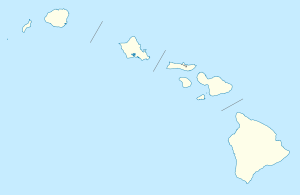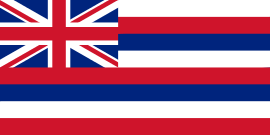Royal Mausoleum of Hawaii
|
Royal Mausoleum | |
|
The main building is now a chapel | |
 | |
| Location | 2261 Nuʻuanu Ave., Honolulu, Hawaii |
|---|---|
| Coordinates | 21°19′30″N 157°50′50″W / 21.32500°N 157.84722°WCoordinates: 21°19′30″N 157°50′50″W / 21.32500°N 157.84722°W |
| Area | 4 acres (1.6 ha) |
| Built | 1863 |
| Architect | Theodore C. Heuck |
| Architectural style | Gothic |
| NRHP Reference # | 72000422[1] |
| Added to NRHP | August 7, 1972 |
The Royal Mausoleum of Hawaii, known as Mauna ʻAla (Fragrant Hills) in the Hawaiian language, is the final resting place of Hawaii's two prominent royal families: the Kamehameha Dynasty and the Kalākaua Dynasty.[2]
Description
The site is located at 2261 Nuʻuanu Avenue in Honolulu, Hawaii on the island of Oahu, coordinates 21°19′30″N 157°50′50″W / 21.32500°N 157.84722°W. The grounds of the mausoleum are surrounded by a black fence, bearing the royal seal of the Kingdom of Hawaii at the gate. A small chapel is located near the center, immediately behind the tomb of Kalākaua and his family, and to the right of the Kamehameha tomb, Bishop Monument, and Wyllie tomb. The chapel, in the shape of a Latin cross, is one of the few examples of Gothic Revival architecture in the islands.[3]
Construction
The 2.7 acre (11,000 m2) mausoleum was designed by architect Theodore Heuck. King Kamehameha IV and Queen Emma planned it as a burial site for their four-year-old son, Prince Albert, who died August 27, 1862. King Kamehameha IV became ill soon afterwards and died November 30, 1863, just 15 months after his son. His brother Lot Kamehameha came to the throne as King Kamehameha V.
Immediately Kamehameha V started construction of the mausoleum building. The Right Reverend Thomas Nettleship Staley, first Anglican Bishop of Honolulu (1823–1898), oversaw construction. The west ('Ewa) wing was completed at the end of January 1864. A large funeral procession February 3, 1864, brought the body of Kamehameha IV from ʻIolani Palace near Kawaiahaʻo Church. His casket was placed on a stand in the new wing. Later in the evening, bearers brought the casket of Ka Haku o Hawai'i (as Prince Albert was known) and laid him to rest alongside his father. Queen Emma was so overcome with grief that she camped on the grounds of Mauna ʻAla, and slept in the mausoleum.[2]
The mausoleum was completed in 1865, adjacent to the public 1844 Oahu Cemetery. The mausoleum seemed a fitting place to bury other past monarchs of the Kingdom of Hawaii and their families. The remains were transferred in a solemn ceremony leading from the burial vault called Pohukaina at ʻIolani Palace to the Nuʻuanu Valley October 30, 1865.[2][4]
Robert Crichton Wyllie, Minister of Foreign Affairs, was buried here in October 1865.[3] Over time, the remains of almost all of Hawaii's monarchs, their consorts, and various princes and princesses would rest at the Royal Mausoleum. Kamehameha I and William Charles Lunalilo are the only two kings not resting at the mausoleum. William Charles Lunalilo, the shortest-reigning Hawaiian monarch, (one year and 25 days only), was buried in a church cemetery resting in the courtyard of Kawaiahaʻo Church. Princess Nāhiʻenaʻena and Queen Keōpūolani are buried on Maui at Waiola Church.
Kamehameha I's remains were hidden in a traditional practice to preserve the mana (power) of the aliʻi at the time of the Hawaiian religion.[2] For several generations, descendants of Hoʻolulu, one of the few chosen to help bury the remains of Kamehameha, have been appointed as caretakers.[5]
Mauna ʻAla was removed from the public lands of the United States by a joint resolution of Congress in 1900, two years after the Annexation in 1898 of Hawaii Territories by President William McKinley.
The Mausoleum is one of the only places in Hawaii where the flag of Hawaii can officially fly alone without the American flag;[6] the other two places are ʻIolani Palace and the Puʻukoholā Heiau.
June 24, 1910, the caskets from the Kalākaua family were moved to an underground vault excavated from rock.[7]
In 1922 the main building was converted to a chapel, and the royal remains were moved to tombs constructed on the grounds. The chapel was added to the National Register of Historic Places August 7, 1972.[3]
Kahu of the Royal Mausoleum

These are the keepers or kahu of the Royal Mausoleum at Mauna Ala:[8][9]
- Nahalau, till 1873[10]
- Joseph Keaoa, from July 10, 1873[10]
- Haumea, from May 3, 1878
- Lanihau, from March 6, 1885[11]
- Keano, from July 31, 1886
- Naholowaʻa, from September 17, 1888
- Poʻomaikelani (1839–1895), from October 15, 1888
- Maria A. Kahaawelani Beckley Kahea (1847–1909), from March 24, 1893 to July 11, 1909
- David Kaipeelua Kahea (1846–1921)
- Frederick Malulani Beckley Kahea (1882–1949), from 1915 to 1947
- William Edward Bishop Kaiheʻekai Taylor (1882–1956), from 1947 to 1956
- Emily Kekahaloa Namauʻu Taylor, from 1956 to 1961
- ʻIolani Luahine, from 1961 to 1965
- Lydia Namahanaikaleleokalani Taylor Maiʻoho, from 1966 to 1994
- William "Bill" John Kaiheʻekai Maiʻoho, from 1995 to 2015[12]
- William Bishop Kaiheʻekai "Kai" Maiʻoho, from 2015 to present[13]
See also
- List of burials in the Royal Mausoleum of Hawaii
- Thomas Nettleship Staley First Anglican Bishop of Honolulu
References
- ↑ National Park Service (2009-03-13). "National Register Information System". National Register of Historic Places. National Park Service.
- 1 2 3 4 Kaiheʻekai Maiʻoho, William John (2003). "Nuʻuanu, Oʻahu - Memories: Mauna ʻAla". Pacific Worlds & Associates. Retrieved 2009-12-08.
- 1 2 3 Riconda, Dorothy (November 15, 1971). "The Royal Mausoleum nomination form" (PDF). National Register of Historic Places. National Park Service. Retrieved 2009-10-13.
- ↑ "Ka Hoihoi Ia Ana O Na Kino Kupapau O Na Alii I Make Mua Ma Ka Ilina Hou O Na Alii". Ka Nupepa Kuokoa. IV (44). November 4, 1865. p. 2. Retrieved October 7, 2016.
- ↑ Apgar, Sally (March 5, 2006). "Mai'ohos feel drawn to royal burial site Six generations have cared for the Nuuanu mausoleum for Hawaii's kings". Honolulu Star-Bulletin.
- ↑ David, Mari-Ela (July 22, 2009). "The Royal Mausoleum, the sacred resting place of Hawaii's Alii". KHNL News. Retrieved 2014-12-22.
- ↑ Thrum, Thomas G. (1911). "New Kalakau Dynasty Tomb". All about Hawaii: The recognized book of authentic information on Hawaii. Honolulu Star-Bulletin.
- ↑ Parker, David Paul (2008). "Crypts of the Ali`i The Last Refuge of the Hawaiian Royalty". Tales of Our Hawaiʻi (PDF). Honolulu: Alu Like, Inc. p. 55.
- ↑ Apgar, Sally (March 5, 2006). "Mai'ohos feel drawn to royal burial site - Six generations have cared for the Nuuanu mausoleum for Hawaii's kings". Honolulu Star Bulletin. Retrieved June 5, 2014.
- 1 2 Kaeo, Peter; Queen Emma (1976). Korn, Alfons L., ed. News from Molokai, Letters Between Peter Kaeo & Queen Emma, 1873–1876. Honolulu: The University Press of Hawaii. p. 14. ISBN 978-0-8248-0399-5.
- ↑ "Lanihau (w) office record". state archives digital collections. state of Hawaii. Archived from the original on March 4, 2016. Retrieved June 17, 2014.
- ↑ Star-Advertiser staff (February 11, 2015). "Hawaii's Royal Mausoleum curator dies". staradvertiser.com. Honolulu Star Advertiser. Retrieved 9 May 2015.
- ↑ Star-Advertiser staff (October 22, 2015). "New curator serving at Oahu's royal mausoleum". staradvertiser.com. Honolulu Star Advertiser. Retrieved December 14, 2015.
External links
- Interactive Map
- D. Thor Minnick (2002). "Mauna'ala:The Royal Mausoleum, Nu'uanu Valley, Oahu, Hawai'i". Minnick Associates. Retrieved 2009-10-13.
- Mauna ʻAla, Royal Mausoleum of Hawaii Photo Gallery
- Historic American Buildings Survey (HABS) No. HI-23, "Royal Mausoleum, 2261 Nuuanu Avenue, Honolulu, Honolulu County, HI", 4 photos, 7 data pages, 1 photo caption page
- Royal Mausoleum State Monument
